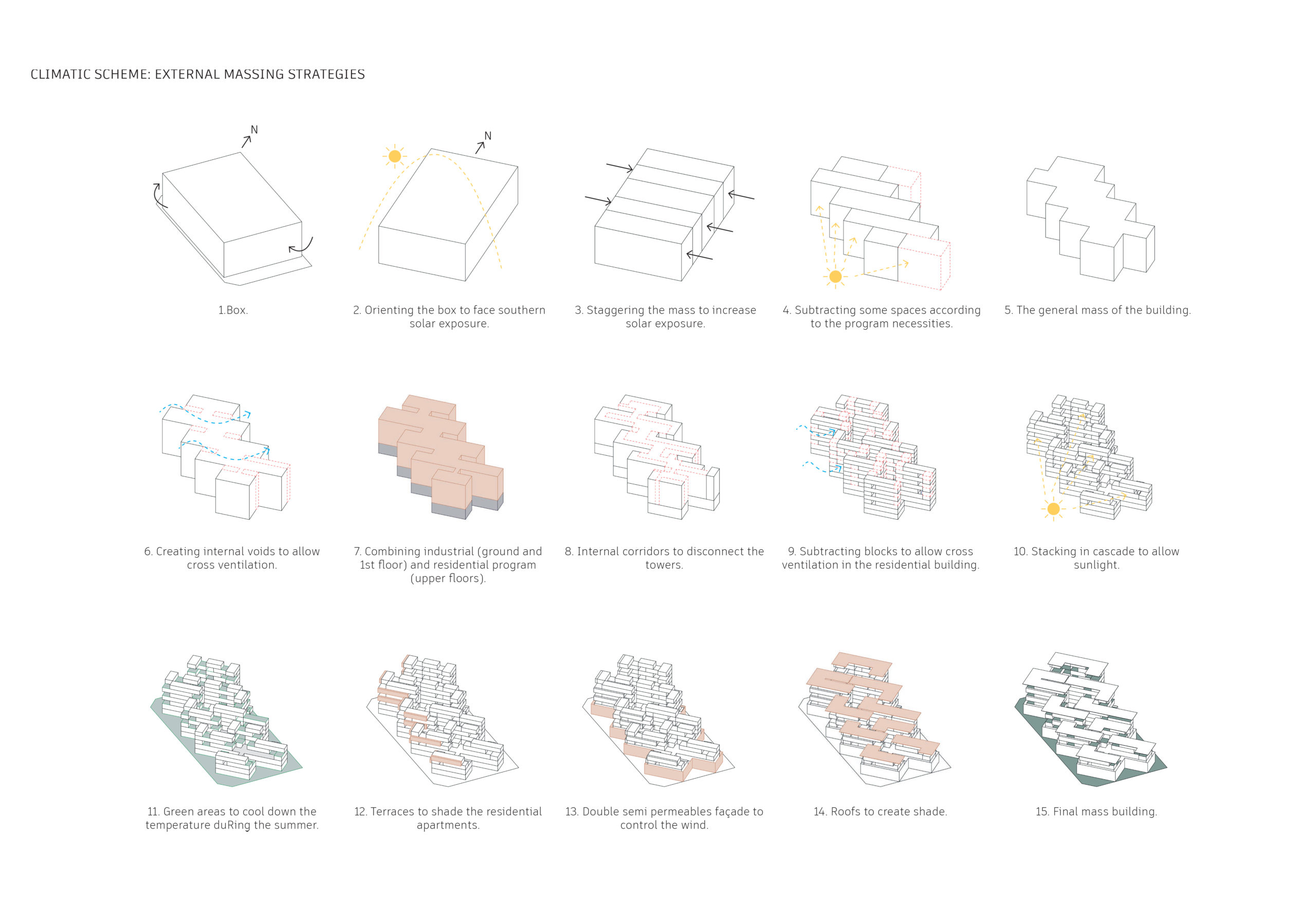The “Urban Alliance” is a mixed-use architectural design seamlessly integrating Industry 4.0 principles, featuring advanced photovoltaic production units. This visionary space harmoniously combines sustainable energy practices with residential and commercial areas, embodying a forward-thinking urban landscape that fosters eco-friendly living and innovative business practices. It exemplifies a holistic and tech-driven approach to urban planning. The project is located in Sant Adrià de Besos, Barcelona. Sant Adrià de Besos is predominantly an industrial zone with minimal high rise buildings placed in its context, as well as scarce natural vegetation. The aim of the thermodynamic fabrications course is to generate a design that is climatically coherent using passive design strategies making the overall scheme a self sufficient project.
Location

Climate Analysis
The first step of designing a passive designed based scheme is to understand the different climatic conditions. This process was done using the software, ‘Climate Consultant‘. Using this method we were able to comprehend the different climate situations, i.e., temperature, wind direction and speed, ground temperature, illumination, humidity, etc,. This data is then utilised to come up with passive strategies to better improve the conditions on site and within the built form.


Human Behaviour Study
Apart from studying the climatic conditions a sociological study was also done to understand the human behaviour during different climate or weather periods. This was done by observing the differences in human behaviour during the summer and winter periods of Barcelona.
During Barcelona’s summer, the city pulses with energy as people flock to iconic sites like La Rambla, Gaudi’s masterpieces, and the beaches. Sidewalk cafes buzz with animated conversations, while tapas bars echo with laughter. Festivals and outdoor concerts abound, fostering a sense of community and shared joy. Locals and visitors engage in water sports, sunbathing, and indulge in the city’s rich culinary scene, creating a vibrant tapestry of diverse summer pursuits.

In Barcelona’s winter, the city undergoes a subtle transformation, revealing a more intimate and cozy side. Locals gather in atmospheric cafes, savoring hot chocolate and churros. The Gothic Quarter exudes a timeless charm with its narrow streets adorned in holiday lights. Catalans celebrate traditional festivals, and the city’s cultural venues thrive with winter-themed events, fostering a sense of warmth and community despite the cooler temperatures.

The Prototype
The next step in design was to understand the passive design options that would be viable for a larger scale. This was done through the design of a smaller scale prototype having very minimal spaces. Passive design strategies such as courtyards, vertical shading elements, thick wall sections, skylights, etc, were implemented to create a passive responsive design.

The prototype is designed to have a workshop space on the ground floor with livable spaces on the upper floor. The design focuses on using cross ventilation and the courtyard effect to naturally cool the spaces. Brisesoleil/vertical louvers are used to maintain natural daylight while mitigating the harsh effects of the sun. A cavity/buffer space is used on the eastern and western sides of the design to create a heat trap which helps in maintaining heat in the winter and keeping the spaces cool in the winter. A skylight is also utilised as a source of daylight but also to remove hot air from the built form.




The Main Design
Following the design of the prototype we focused on designing our main project. The main project known as ‘Urban Alliance’ is a mixed use built form comprising of industrial, residential, commercial, research, etc, spaces.

The built form is designed on the basis of passive design strategies. To begin with, the entire built form was oriented along the north-south direction. This was done to maximise the amount of day-lighting that occurs in all spaces. The building blocks are then staggered to further improve day-lighting as well as facilitate natural ventilation. The built form is staggered in both the horizontal and vertical axis to create opportunities for passive design strategies. Green spaces are also utilised to create a more ambient micro climate on site and within the built forms. Passive design strategies like natural ventilation, natural day-lighting, trombone walls for thermal mass, perforated wall for ventilation, brisesoleil/vertical louvers/secondary permeable facades for diffused lighting, skylights for lighting and ventilation and green roofs are utilised in the design.

During the summer the aim is to keep the insides of the built form cooler than the outside. This is achieved through the use of vegetated spaces, secondary facades which reflect heat, skylights to remove hot air, and large openings to facilitate natural ventilation.



During the winter the aim is to retain heat within the built form. This is achieved utilising the same strategies but functioning in a different manner. Secondary facades trap heat and release it slowly into the built form, closed skylights prevent the heat from escaping the building and large glass opening act as a thermal heat gain to capture more heat.



Radiation Analysis
After applying the passive strategies to the built form we simulated the design to undergo a radiation analysis using ladybug a plugin of the grasshopper software. It was observed that in the winters the building experiences the necessary amount of heat gain to maintain an ambient temperature on the interior spaces and during the summers the building is naturally cooler due to the passive strategies applied.


